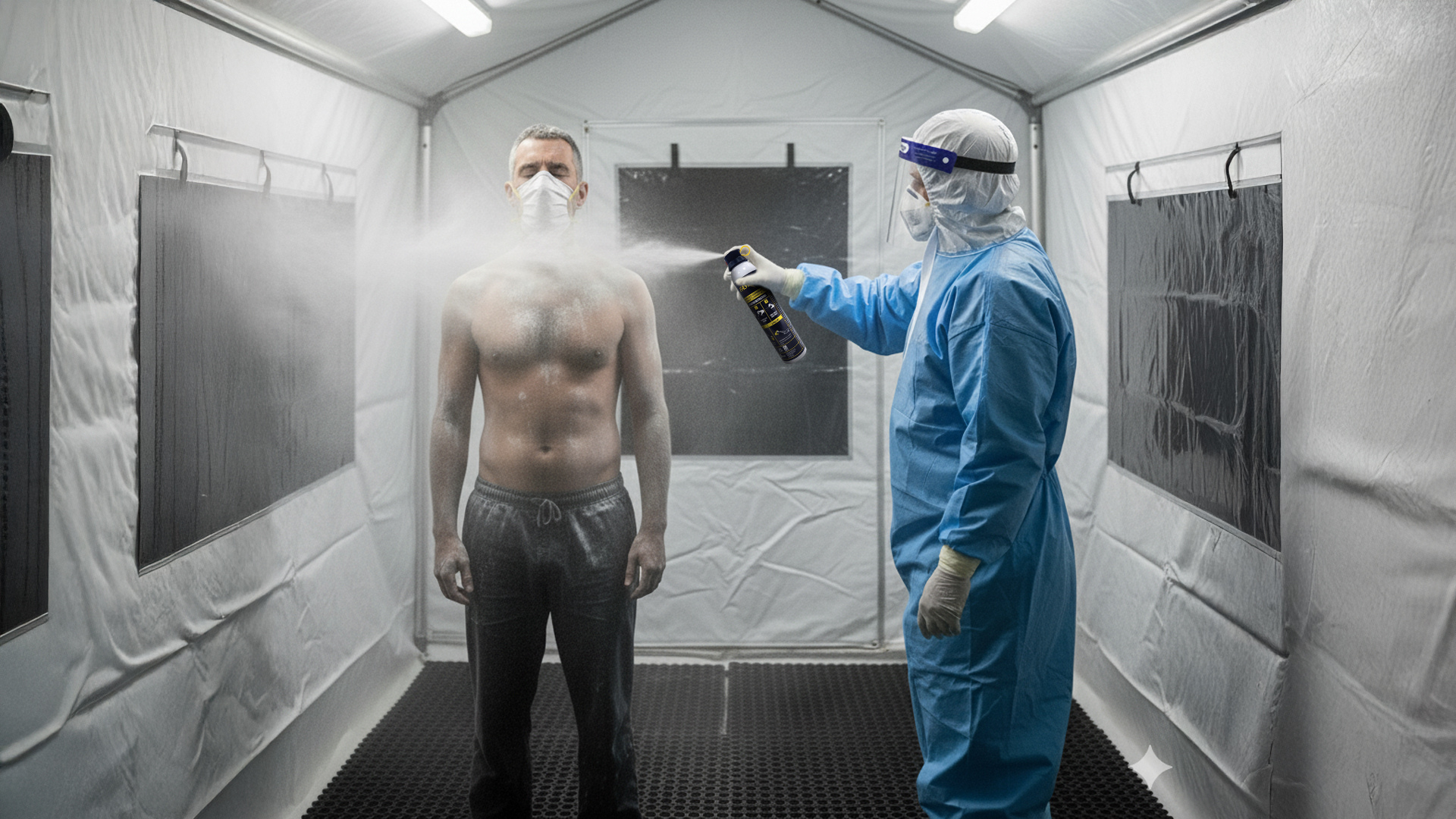Hospital Dry Decontamination: A Faster, More Efficient Approach to Emergency Response
During a mass casualty incident involving chemical agents or hazardous materials, every second counts. Hospitals must act quickly to protect patients, staff, and infrastructure while maintaining operations within the hospital environment. Traditional wet decontamination systems, which rely on large volumes of water and extended setup, can slow down an emergency response when speed is critical.
That’s where dry decontamination transforms hospital readiness. FAST-ACT®’s proven decontamination technology gives healthcare facilities the ability to respond faster and more efficiently as part of their emergency preparedness program. By reducing water use, setup time, and manpower requirements, FAST-ACT supports hospitals with a rapid, cost-effective, and scalable approach to patient decontamination that meets the demands of modern disaster response.
Hospitals that integrate FAST-ACT into their hospital decontamination programs improve operational efficiency while maintaining compliance with best practices outlined by the Chemical Hazards Emergency Medical Management (CHEMM) program. CHEMM highlights the importance of dry decontamination in minimizing patient exposure time and improving overall disaster response outcomes.
In this blog, we will explore how dry decontamination accelerates hospital emergency response, saves operational costs, and strengthens overall decontamination capabilities using FAST-ACT’s products.
The Time Factor in Hospital Decontamination
In hospital decontamination programs, time directly impacts outcomes. According to the U.S. Department of Health and Human Services, patients exposed to chemical agents must undergo decontamination procedures within minutes to reduce injury severity and mortality. However, traditional wet systems can slow down an emergency response.
Setting up traditional decontamination stations and protocols typically requires plumbing connections, temperature regulation, and additional emergency responders for crowd control and patient handling. These steps can take 20 minutes or more—time hospitals cannot afford during a mass casualty event.
By contrast, FAST-ACT’s dry decontamination procedures allow hospitals to begin patient decontamination immediately, often before patients enter the emergency department. This rapid capability reduces secondary exposure risks and enhances staff safety.
FAST-ACT: Rapid Deployment When Every Second Counts
FAST-ACT’s Hospital Standard Operating Procedure outlines a clear process for hospitals looking to improve decontamination capabilities under their emergency response plans or facility response plan. The SOP centers on three key FAST-ACT products that form the foundation of hospital emergency management programs.
The FAST-ACT® 400g Pressurized Cylinder provides full-body decontamination in seconds, neutralizing chemical agents and hazardous materials while preventing off-gassing. The dry powder formula adheres to contaminated surfaces and clothing, protecting both patients and emergency responders.
For localized surface and skin decontamination, the FAST-ACT® Decontamination Mitts and FAST-ACT Decontamination Wipes enable targeted application. Together, these tools deliver fast, effective solutions that help maintain patient safety during hospital decontamination.
FAST-ACT simplifies and accelerates the hospital decontamination process. It gives teams the ability to begin chemical decon within minutes—right where patients arrive—without waiting on complex system setup or large-scale infrastructure. The process is efficient, reduces turnaround time between patients, and minimizes cleanup requirements. Because FAST-ACT’s dry application limits contaminated waste and water runoff, post-incident cleanup is faster, safer, and more cost-effective for the facility.

The Financial Advantage of Dry Decon
Speed is vital, but cost efficiency also matters. Traditional wet decontamination procedures involve multiple steps that increase time and expense, including water setup, containment, temperature regulation, and runoff management. Each step requires additional personnel, equipment, and oversight, driving up operational costs during emergency response.
FAST-ACT helps hospitals lower costs by eliminating the need for water during the initial response phase. Its products are simple to use and require minimal training—no specialized certification or equipment instruction is needed. This simplicity allows smaller teams to perform decontamination effectively while optimizing staffing and training budgets within emergency preparedness programs. Additionally, FAST-ACT eliminates the need for multiple products for different chemical threats, as it neutralizes a broad range of known and unknown contaminants, reducing both procurement and operational complexity.
Over time, these operational efficiencies strengthen a hospital’s emergency management program, enabling better coordination, more sustainable budgets, and a higher level of readiness across the system.
Supporting Medical Management and Patient Safety
For emergency healthcare providers, dry decontamination simplifies patient management and enhances safety in the hospital environment. It enables faster triage, reduces hypothermia risk from prolonged water exposure, and limits contamination spread via water runoff.
Dry decon also supports the use of personal protective clothing by emergency responders, minimizing direct contact with hazardous substances. This method is especially useful when large numbers of patients require attention, as it allows for quick turnover while maintaining compliance with national decontamination procedures and emergency response plans.
When used in combination with water decontamination, FAST-ACT provides a two-step process—rapid neutralization followed by thorough cleansing—ensuring that all contaminants are fully addressed without compromising hospital workflows or facility response plans.

Real-World Application: From the Field to the Hospital
FAST-ACT has been adopted by fire departments, hazardous material teams, and hospitals as part of their broader emergency preparedness programs. Its portability, ease of use, and reliability make it a valuable tool in both pre-hospital and hospital decontamination settings.
In emergency situations, coordination between emergency responders, hospital staff, and incident command is critical. FAST-ACT’s simplicity supports smoother integration into existing communications equipment protocols and emergency response equipment systems, improving overall coordination during chemical exposure events.
The Future of Hospital Decontamination Efficiency
As hospitals update their emergency management programs and CBRN response plans, the need for adaptable, fast-acting decontamination procedures has never been greater. FAST-ACT’s dry decontamination technology combines operational speed, cost control, and proven chemistry to deliver results that fit seamlessly within existing hospital decontamination programs.
By reducing setup time, improving coordination, and enhancing decontamination capabilities, FAST-ACT gives hospitals the flexibility to act decisively when every second matters. These tools empower facilities to strengthen their emergency preparedness programs, streamline facility response plans, and maintain a safe and ready hospital environment.
FAST-ACT® delivers solutions that allow hospitals to respond faster, safer, and more efficiently— protecting patients, staff, and facilities when time and money matter most.
Learn more about how FAST-ACT supports hospital emergency response and preparedness by reaching out to our team.

About Timilon Corporation:
Timilon Corporation is the manufacturer of FAST-ACT®, a proprietary formulation of non-toxic high-performance specialty materials effective at neutralizing a wide range of toxic chemicals with the added capability to destroy chemical warfare agents. The FAST-ACT technology is utilized by leading defense agencies, chemical industrial companies, first responders and HAZMAT teams to quickly and safely eliminate chemical hazards. For more information, reach out to Leticia Menzzano, Marketing Manager, lmenzzano@timilon.com.

